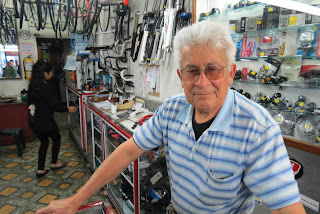 |
| Jose Duarte with one of his elegant hand-made frames. |
 |
| Bicicletas Duarte on Calle 68 in Bogotá. |
So, hard to believe that in the store's rear workshop you can find a legend of Colombian cycling.
 |
| The Duarte frame which won France's Tour del Avenir. |
Born in the town of La Mesa outside of Bogota, as a teen Duarte bicycled to his electrician job. But at age 17 he discovered that his real vocationlay not in the plugs and wires he worked with, but the pedals and wheels he used to get there.
 |
| Duarte's hand-made frames hang on a wall. |
A Career Shift
In 1965, Duarte switched from riding bikes to building them, opening his first workshop.
The afternoon I dropped into Bicicletas Duarte, Duarte had just placed the latest classic lugged racing frame he was building into an acid bath. It may be one of the last of some 6,000 frames molded by his hands.
Strikingly, even more than his own accomplishments on two wheels, Duarte seems proudest of what others have accomplished on Duarte-made frames. In the 1978 Vuelta a Colombia, 35 of the the 90 racers rode Duarte frames. Duarte bicycles have won 6 Vueltas a Colombia, as well as the vueltas of Chile, Mexico, Costa Rica, Panama, Guatemala and Venezuela - and undoubtedly others as well. But the greatest achievement is memorialized on his shop wall in the form of the dark blue frame which won France's 1985 Tour del Avenir. The facing wall exhibits snapshots of Duarte with cycling legends including Bernard Hinault and Eddy Mercx, who visited his shop.

Duarte built bikes for Rafael Niño, who won the Vuelta five times, as well as Miguel Samaca, Cristobal Perez and other Colombian cyling legends.
Politicians and Pablo Escobar
 |
| Inside Bicicleta Duarte's repair shop. |
Galan "was not such a good cyclist," Duarte recalls, "but he was a good politician."
 |
| Duarte's showroom, which sells mass-produced bikes from Asia. |
Ironically, in the early 1980s Duarte had also built bike frames for drug capo Escobar himself, altho
Duarte says that at the time Escobar's business was little known.
 |
| Duarte, left, fitting politician Luis Carlos Galan. |
Escobar financed a bicycle racing team and a bicycle factory named Ossito, as well as football teams and other sports. His brother Roberto was a talented bike racer until he got involved in Pablo's business.
"He exported those frames," Duarte says of Escobar. "Nobody knew what they put inside."
When they traveled overseas to race, Escobar's cyclists doubled as cocaine smugglers. In the end, some were killed, others did prison time.
 |
| Jose Duarte examines a racing bike's wheel. |
Changing Cycling Culture
Sadly, cycling culture has become profoundly corrupted by doping since Duarte's era. Inevitably, suspicions surround every outstanding cyclist, including Quintana.
 |
| Duarte with bike racing buddies Hernan Herron and Jorge Luque. |
Meanwhile, bicycles have also evolved into hi-tech, computer-equipped machines built around frames made of aluminum and sophisticated alloys. Asian, factory-made aluminum bikes have captured the popular market. The racing frames Duarte makes by hand out of steel and chromium-molybdenum tubing are sought only by those who love classics.
"These cost a million pesos," he says of his frames. In comparison, fat-tubed aluminum frames "cost 300,000 pesos." He motions again at his own elegant creations. "Nobody wants these."
Perhaps that what's left Duarte feeling a bit resigned and tired.
His Final Frames?
 |
| Jose Duarte in his shop. |
Today, others also make custom bicycle frames in Bogotá - mountain bikes, fixies, etc - but Duarte doesn't rate them highly.
"Those are common frames," he says. Except for himself, "Nobody makes fine frames."
Grudgingly, Duarte's family business has evolved with the times. His two sons who have pursued careers with bicycles repair aluminum and carbon fiber frames. As for himself, Duarte says he's about done with frame building.
"I'm tired," he says, standing in his workshop beside a row of steel Duarte frames. "I don't want to make any more frames."
But his decision is not absolute. He will still build frames for friends, altho that will depend on the outcome of the spinal surgery he has scheduled for the coming weeks to repair several lower back vertebrae damaged from decades leaning over bicycles.
Duarte doesn't make hand-made steel tube frames to be fashionable or retro. He does it because they're all he knows and because he likes their slim, simple elegance. I left Duarte's shop with terribly mixed feelings - impressed with the man's skill and dedication, but sad about the twilight of an era of artesanal framebuilding.
"People have lost their love for these artesanal frames," laments Claudia Reyes, Duarte's daughter in law, who manages the bike shop. "Working on them isn't easy."
Thanks to the great Colombian bike racing blog Cycling Inquisition, where I first read about Jose Duarte.
By Mike Ceaser, of Bogotá Bike Tours

No hay comentarios:
Publicar un comentario